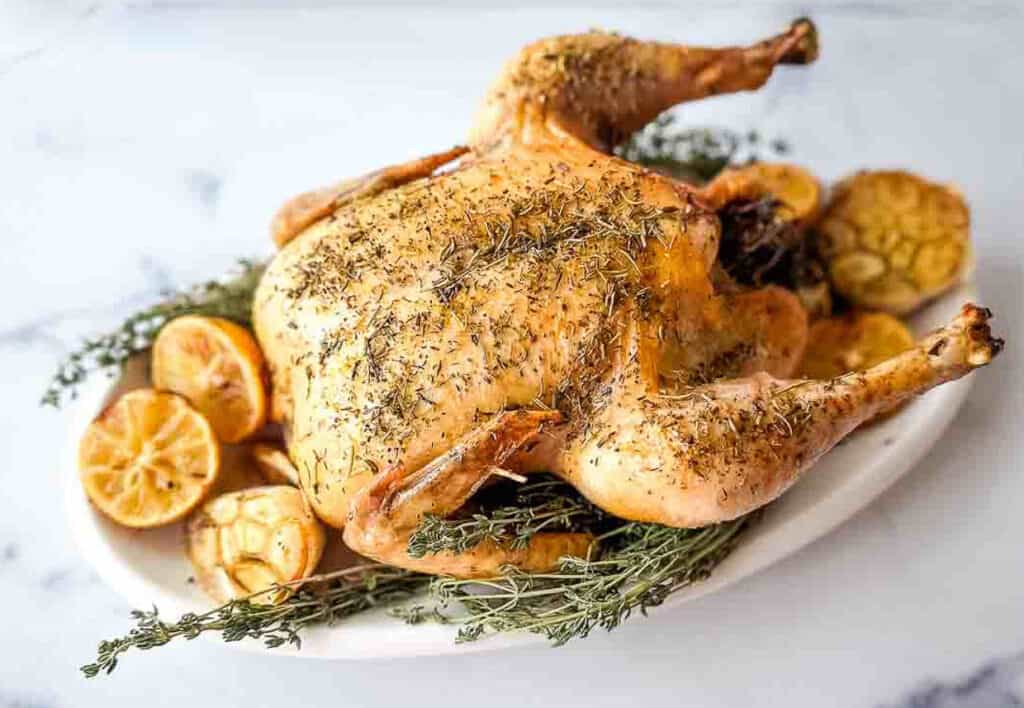Majoram has a mild and sweet flavor, often compared to a blend of thyme and oregano. Adding nuanced, earthy notes that are both floral and citrusy, marjoram is a wonderful addition to recipes that range from roast meats to tomato-based sauces to infused oils. This guide will provide all of the information you need to prepare, cook and store fresh marjoram to preserve its flavor and texture.

Photo credit: Fire and Saw.
Selecting fresh marjoram
Marjoram is a perennial herb that grows best in a sunny, warm, but sheltered area. It thrives in the spring and summer, producing small, soft, gray-green leaves. Plants vary in height from about 1 to 2 feet tall.
If you have the time and space, you can grow herbs inside or in an outdoor garden. However, you can also find marjoram at many grocery stores and markets year-round.
“I love the spreading marjoram in our garden. We have it growing along a rock wall on a frequently used garden path; every time I walk past and disturb it, a wonderful fragrance fills the air. ”
— Dan Morris, Fire and Saw
When selecting a bunch of marjoram at the store, be sure to choose one that is fragrant, with pliable stems that are neither wilted nor brittle, with vibrant green leaves and no signs of excessive moisture. Black and brown spots on the leaves indicate that the marjoram is no longer fresh.
FDL’S 75 Best Bites

Our cookbook with 75 tasty recipes will be your go-to kitchen companion for easy dinners with ad-free recipes right at your fingertips. Crafted by experienced chefs and recipe developers, this collection offers a treasure trove of tried-and-true dishes that make mealtime a breeze.
Get the Recipe: FDL’S 75 Best Bites
The taste of marjoram
Marjoram has a mild, savory, citrusy flavor that includes sweet, floral notes. Its flavor is less intense than many other fresh herbs like oregano, thyme or rosemary. Instead, it provides a subtle flavor that complements a variety of proteins, grains and vegetables. It is also delicious in teas, infused oils and herb butter.
“I usually swap out dried marjoram for oregano because I prefer its flavor — it’s like oregano but less intense. I add it to sauces, soups, stews, dipping sauces and eggs. I feel marjoram doesn’t get much attention, but it seriously adds some tasty notes to my dishes.”
— Jere’ Cassidy, One Hot Oven
Cleaning marjoram
If you are planning to cook with storebought marjoram, first remove all of its packaging, including plastic clamshells, rubber bands or twist ties. Then scan the bunch to see if there are any wilted, dried, brown or black leaves. Remove any dirt or debris, and run the marjoram under cool water. Pat it dry with a kitchen towel or run it through a salad spinner to remove any excess moisture.

Photo credit: Fire and Saw.
Storage suggestions
Majoram is considered a soft herb like cilantro, dill, basil, sage or parsley, so it must be stored properly to preserve its flavor and texture. The most common storage option is to wrap marjoram in a damp paper towel, place it in an airtight container and store it in the refrigerator.
You can also hang marjoram to dry using a piece of twine. Store it in a cool, dry place until fully dried and then store it in an airtight container. A dehydrator will also work for this purpose.
Marjoram can also be frozen. Wash the marjoram leaves as recommended, remove them from the thick stem and add them to the individual compartments of an ice cube tray. Pour water over the herbs to cover and freeze for later use. You can add frozen marjoram to soups, stews and sauces. The defrosted herbs will not hold up well in fresh dishes like salads.
Culinary uses for fresh marjoram
When using delicate herbs, add them near the end of the cooking process. Fresh marjoram can also be used as a garnish for dishes like pasta,
Marjoram is a popular flavor for roasted meats like roast chicken, roast lamb, beef and pork. You can also try it in a variety of oils, teas and butter as a flavoring agent.
“Marjoram’s mild, sweet, aromatic flavors enhance stews, sausages, lentil dishes and even salads. The Mediterranean cuisine prominently calls for marjoram in foods such as in the French Herbes de Provence seasoning blend and the vegetable-loaded southern French Ratatouille stew.”
— Marina Helene, Masala Herb

Fresh marjoram is primarily used in savory dishes. It’s used in Greek, Italian, French, Middle Eastern and North African cuisines and is commonly used interchangeably with oregano. However, marjoram is sweet and oregano is more bitter, so be aware of this distinction when choosing a fresh herb for your dish.
Final thoughts
Majoram is a perennial herb that prefers warm, sunny, sheltered environments. You can grow it indoors or outdoors. It’s added to a wide variety of savory dishes, from roast chicken to tomato-based sauces, and can be served as a garnish as well. Its sweet, mild flavor is similar in taste to both oregano and thyme.
Marjoram is available at grocery stores year-round. It’s best to choose bunches with fragrant, soft, grayish-green leaves. Avoid bunches with dried-out or wilted stems or leaves, as well as brown and black spots on the leaves. Marjoram can be dried or stored in the fridge or freezer.
As with other delicate herbs, marjoram is added near the end of the cooking process. It’s popular in the cuisines of many cultures, including Italian, Greek, French, Middle Eastern, and North African cuisines. If you see fresh marjoram at the store, be sure to pick up a bunch and experiment with adding it to new dishes. You are bound to find a world of delicious possibilities.
Gen La Rocca is a professional chef, writer and editor living in Southern California. She is the owner and recipe creator behind Two Cloves Kitchen, a food site featuring contemporary, California-inspired recipes. She has edited over 20 novels, short stories and essays for publication.